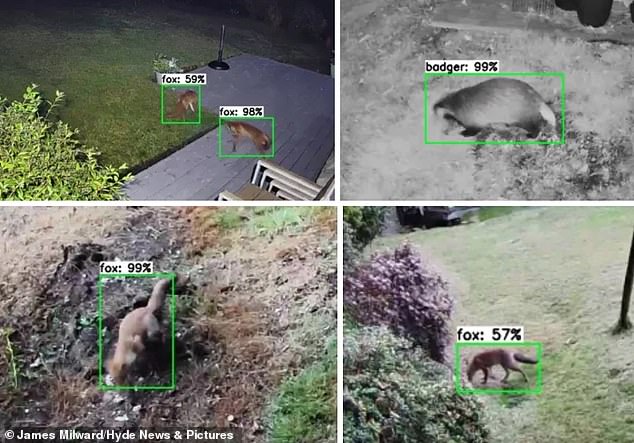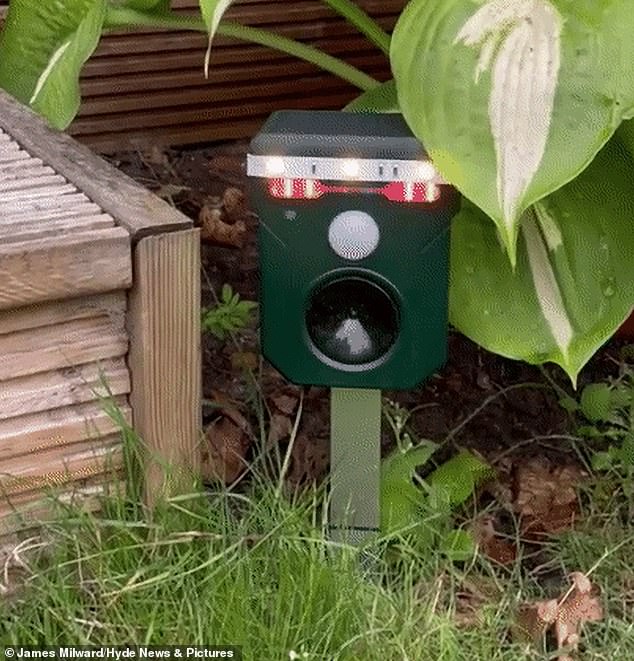‘Furbinator 3000’: Man trains his Ring camera to emit high frequency sounds that keep pesky foxes and badgers away from the garden
>
A clever Brit has come up with a solution to keep foxes and badgers out of his garden, without using inhumane traps or chemical repellents.
James Millward, an IT expert from Surrey, has trained artificial intelligence (AI) software so it can recognize mammals in live feeds from his Ring smart camera.
Once a fox or badger is detected, it emits a high-frequency sound wave, inaudible to any human, which scares away the curious animal rather than harming it.
Although generally not harmful to humans, foxes and badgers are considered pests as they can dig up flower beds, rotten lawns, and raid compost bins.
Millward has written about how he developed the technology, which he called the “Furbinator 3000,” so that anyone could build their own version at home.

An IT expert has trained artificial intelligence (AI) software so it can identify foxes and badgers in live streams from his Ring smart camera.

When the Furbinator 3000 detects a fox or badger, it emits a high-frequency sound wave, inaudible to any human, scaring the animal away
Mr. Millward outlined his clever solution in a lengthy blog post on the publishing platform Mediation.
However, it is clear that anyone following its difficult instructions will need to have a good programming background to understand it.
The IT expert used machine learning (ML) software, a specific subset of artificial intelligence that allows systems to learn from data and then come to new conclusions.
“The recent influx of foxes and badgers into my garden and the damage that has followed has given me the perfect opportunity to think about how I can learn and use machine learning to try and reduce the number of unwanted visitors at night,” he said.
“I set myself a goal of building a tool that could deter badgers and foxes without causing them any harm.
You may be reading this thinking that machine learning is overkill to build a wildlife deterrent.
“Maybe you’re right, but I absolutely love crazy projects and I’ve tried many humane solutions to safely stop my unwanted guests in the park, all of which have failed.”
Initially, to keep pests away, Millward was using a few solar-powered ultrasonic repellents, which use infrared sensors to detect heat from nearby objects and emit an audio warning.

If you want to build your own Furbinator 3000, you’ll likely need to have a good programming background

Mr. Millward explained his solution in a blog post on Medium, though it’s clear that anyone following his instructions would need to have a good background in programming.
Although they were successful in reducing the number of nighttime visits, he found some problems with the ultrasonic repellents.
“It works 24/7, which means we turn it on when we’re in the park, turning it off and forgetting to turn it back on periodically,” he said.
“The deterrent has different modes for badgers and foxes which must be set manually, resulting in some areas of one animal species not being covered.”
So he modified the device so it had a built-in Ring camera and worked with TensorFlow software, though as his blog post shows it wasn’t easy at all.
He had to train it using “a good set of images” – 240 annotated images – before he was convinced he could work with new real-world footage.
Along the way, the expert had difficulty correctly identifying objects and frequently mistook non-threatening objects for pests.
“After some testing, I started to notice a number of false positives from the system,” Millward said.
“Fortunately, most of these false positives were obtained from stationary objects such as fallen leaves, grass patterns, or debris caught in cobwebs.”

Ring is a suite of smart home solutions from Amazon that provide live streaming for owners to monitor their properties remotely
Many homeowners don’t mind having badgers or foxes in their gardens – in fact, many wildlife lovers actively encourage them through food scraps.
But Mr Millward said he wanted to protect his children from potential diseases they could carry, which could include tuberculosis.
This is despite the Royal Society for the Prevention of Cruelty to Animals (RSPCA) criticizing ultrasonic repellents as being “aversive to some animals, which may cause them discomfort, fear and/or pain”.
“I understand the importance of living in harmony with our wildlife, so much so that we have an active ground beehive in our garden which I make sure to keep because we are in desperate need of more pollinators and they are not causing us any harm.” said Mr. Millward.
“However, foxes and especially badgers can cause a huge amount of damage in a short period of time.
“I have two young children and this poses more problems because this kind of wildlife brings with them bad insects and diseases.”
While badgers are most closely associated with tuberculosis, urban foxes can also carry a range of parasites and diseases that can affect the health of people and their pets.
However, the government’s Department for Environment, Food and Rural Affairs says dogs, which are susceptible to a similar range of diseases as foxes, may be a more important source of infection for humans.
(tags for translation) Daily Mail

